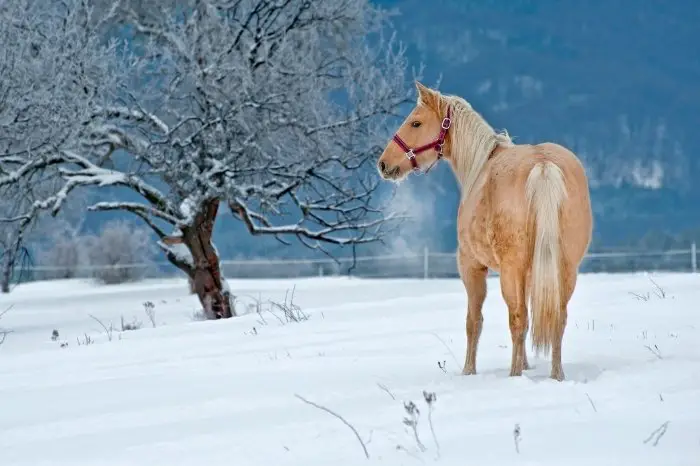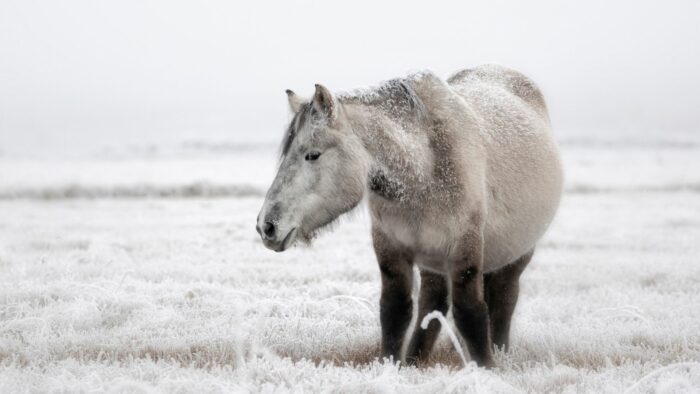Last Updated on April 7, 2023
With thousands of horse breeds from around the world, there are many cold weather horse breeds as well as horses that can thrive in hot climates. Let’s take a look at how different horse breeds can cope with extreme weather conditions!
How Are Horses Adapted to Cope With Cold Weather?
Before horses were domesticated, they lived like wild animals in different regions all around the world. Some were in hot countries, while others managed to survive in some of the harshest weather conditions. This has led to the many different types of horses we know and love today.
Horses are generally classified into one of three types: warm-blooded, cold-blooded, and hot-blooded. Cold-blooded breeds are those that are adapted to live in colder climates, whereas hot-blooded horses are from warmer regions. A warmblood is normally a horse with genetic influences from both cold and hot-blooded horse breeds.

For example, it is common to cross a draft horse, which iscold-bloodedd, with a Thoroughbred, which is hot-blooded. The result is an awarm-bloodd horse.
Cold Weather Horses Characteristics
All of the horse breeds that originate from cold and harsh climates are cold-blooded breeds, and they have many characteristics in common.
Cold weather horse breeds will grow a thick, dense coat in the autumn, ready for the cold winter months. This coat often has a double layer, with a dense, thick undercoat and longer hairs that form the second layer.
This thick coat has two functions. Firstly, it can trap warm air against the body, underneath the longer hairs. This insulating layer prevents heat from being lost from the body in cold weather
Secondly, the longer hairs allow rain to run down the coat and off the body. The hairs underneath will stay dry and warm. The horse may appear saturated, but if he can shelter from direct rain then he will stay warm and dry.
Another way in which cold-weather horse breeds stay warm is through their body shape and stature. These horses are normally quite stocky in build, with a wide chest and abdomen. The abdominal cavity is a major source of heat as a result of the digestive processes that occur when a horse eats, and a stocky body means a warmer horse! Cold-blooded horses are also typically able to sustain themselves on lower-quality forage. In a natural cycle, they will put on more weight in the summer when the grass is more nutritious. They will use this excess body fat during the winter to maintain their body heat.
Click Here to Learn About:
What is the Coldest Weather Horses Can Tolerate?
The level of cold that a horse can tolerate will depend on several factors, such as the breed and age of the horse. It will also depend on how well the horse is adapted to living in the cold, and the type of weather conditions they are living in.
For example, a geriatric hot-blooded horse, such as an Arabian, will have a very low tolerance for cold weather. These horses frequently need extra blankets and feed during the coldest months to prevent them from losing too much body condition.
At the other end of the equine spectrum, the highest (or lowest!) horse cold tolerance is in those breeds that are adapted to survive near-arctic conditions. These horses, with a thick winter coat and adequate shelter, can thrive in temperatures as low as -40 degrees Fahrenheit.
However, if the weather is wet and windy, and there is no adequate shelter available, even the hardiest horses will succumb to hypothermia at lower temperatures. The combination of a wet coat and chilly winds causes the horse to lose body heat very rapidly, so good shelter and protection from the rain are essential.
Horses also need to significantly increase their feed intake to stay warm during extremely cold weather. Once temperatures drop below 30 degrees Fahrenheit, the feed intake will need to increase by up to 20% for every 10-degree reduction in temperature. The extra calories are used to help maintain body heat, and the horse’s digestion system also works like a central heating system, generating heat through the digestive processes in the large intestine.
Which Are the Best Cold Weather Horse Breeds?
To find the best cold weather hose breeds, we need to look for breeds from cold countries. Here are some of the most famous hardy horse breeds from around the world:
-
Shetland pony
The Shetland pony is one of the hardiest pony breeds in the world and can survive in extremely cold weather. This pony is famous for its incredibly long double coat, which provides excellent insulation during the winter.
The Shetland Isles are 120 miles north of Scotland, in the North Sea. The weather there is not only cold but also very wet. This hardy and tough little pony can survive freezing temperatures and icy cold wind and rain, taking shelter in nooks on the hillsides. For their size, Shetland ponies are powerful and can pull heavy loads that are many times their own body weight.
-
Icelandic horse
Talking of cold countries, Iceland is one of the most extreme! The Icelandic horse is famous for its thick, dense coat, topped with an impressive mane and thick forelock. These horses thrive in the harshest of weather, including snow, hail, and icy rain.
This cold-blooded horse breed is linked to Shetland ponies and also horses from Norway and Mongolia. Viking explorers returned from expeditions with breeding stock, and these founded the Icelandic horse bloodlines.
-
Norwegian Fjord horse
The Norwegian Fjord Horse is a very distinctive breed of horse, with a proud, arched neck with a characteristic upright mane. This horse breed has one of the oldest and purest bloodlines in the world, dating back over 4 thousand years. They were once used as Viking warhorses, but in modern times you are more likely to find them hauling timber or pulling a wagon.
This horse breed is not only adapted to survive in cold weather but is also very sure-footed in ice and snow. Fjord horses are all dun and have distinctive primitive markings including a dark dorsal stripe and zebra markings on the legs.
-
Yakutian (Yakut) horse
The Yakutian horse is one of the hardiest arctic horse breeds you will ever come across! Originating from Siberia, these pony-sized equines have stockyphysiquese and dense furry coats to enable them to stay warm at extremely low temperatures.
The body shape of the Yakutian horse is adapted to reduce heat loss, with short stumpy legs and a sturdy body. They tend to gain much weight during the fall, preparing them for the long, cold winter months ahead. During the coldest months, their metabolism slows, reducing energy needs and weight loss.
-
Bashkir horse
The Bashkir is one of the most unusual cold-weather horse breeds you will come across, as it can survive in both extreme cold and extreme heat! Originating from mountainous regions of Russia, herds of Bashkir horses roam outdoors in blizzards during the winter months, with temperatures as low as -40 degrees Fahrenheit. In the summer, peak temperatures can reach over 90 degrees Fahrenheit.
The other notable aspect of the Bashkir horse is its curly coat, which is very rare amongst horse breeds. They are commonly kept for farm work, and prized for their placid temperament and incredible endurance skills. Bashkir horses are also used for milk production, and when they shed their winter coats the curly hair can be woven into cloth.
Summary – Cold Weather Horse Breeds
So, as we have learned, the best cold-weather horse breeds are those that originate from harsh climates in the far north. These types of horses grow a thick, dense coat that traps warm air and repels rain. Cold-blooded horse breeds are also able to sustain themselves on poor-quality forage to maintain their body weight through cold weather.
We’d love to hear your thoughts on cold-weather horse breeds! Is your horse a complete wimp who needs a blanket as soon as it turns a bit chilly? Or perhaps you’re worried that your horse might not be warm enough in winter? Leave a comment below and we’ll get back to you!
FAQs

Kate Chalmers is a qualified veterinary nurse who has specialized in horse care for the vast majority of her career. She has been around horses since she was a child, starting out riding ponies and helping out at the local stables before going on to college to study Horse Care & Management. She has backed and trained many horses during her lifetime and competed in various equestrian sports at different levels.
After Kate qualified as a veterinary nurse, she provided nursing care to the patients of a large equine veterinary hospital for many years. She then went on to teach horse care and veterinary nursing at one of the top colleges in the country. This has led to an in-depth knowledge of the care needs of horses and their various medical ailments, as well as a life-long passion for educating horse owners on how to provide the best possible care for their four-legged friends.
Kate Chalmers BSc (Hons) CVN, Dip AVN (Equine) Dip HE CVN EVN VN A1 PGCE


